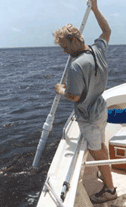Home » Projects » Shellfish Farm Environment Projects » Sulfide Concentrations in Sediments and Water and Their Effects on hard Clams
 This study integrated field surveys and laboratory experiments to determine the 1) hydrogen sulfide exposure levels of hard clams and relationships among sediment hydrogen sulfide and various environmental parameters in the Suwannee River estuary, and 2) effect of hydrogen sulfide on the survival of two size classes of hard clams. Sediment porewater samples were collected at 11 sites, both inside and outside of shellfish aquaculture leases in Levy and Dixie Counties. In the lab, two sizes of clams were challenged with both sulfide and hypoxia (low oxygen).
This study integrated field surveys and laboratory experiments to determine the 1) hydrogen sulfide exposure levels of hard clams and relationships among sediment hydrogen sulfide and various environmental parameters in the Suwannee River estuary, and 2) effect of hydrogen sulfide on the survival of two size classes of hard clams. Sediment porewater samples were collected at 11 sites, both inside and outside of shellfish aquaculture leases in Levy and Dixie Counties. In the lab, two sizes of clams were challenged with both sulfide and hypoxia (low oxygen).

